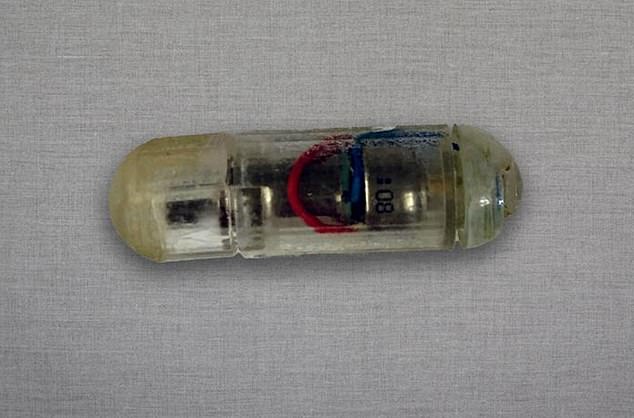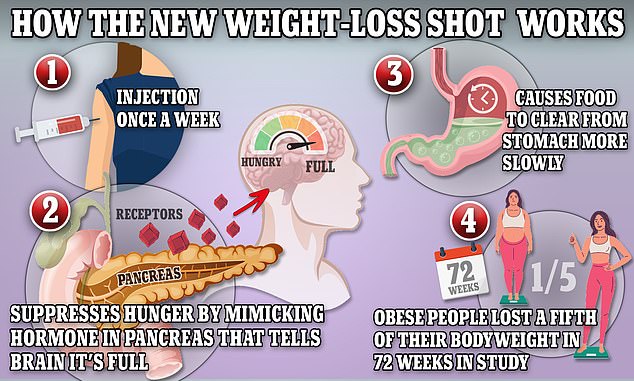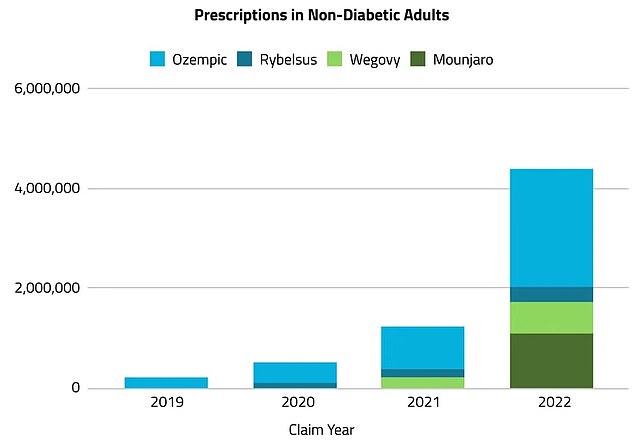Could THIS be the new Ozempic? Researchers unveil vibrating pill that spurs weight loss by shaking stomach into thinking it is full
People could lose weight quickly by taking a vibrating pill before each meal, scientists say.
Researchers at the Massachusetts Institute of Technology have developed a capsule the size of a multivitamin that tricks the stomach into thinking it is full.
Animal tests showed that pigs who took the pill 20 minutes before eating consumed an average of 40 percent less food compared to a control group.
The device has yet to be tested on humans, but the researchers say it has a “profound” effect on appetite and could provide a way to “lose weight or control appetite.” They say it also had no side effects such as nausea and vomiting, which occur with Ozempic.
The above image shows how the vibrating pill can be used to curb appetite and stimulate weight loss. It works by vibrating in the stomach and tricking the organ into thinking it is full, sending signals to the brain that suppress appetite.

Researchers at the Massachusetts Institute of Technology found that vibrations from the device tricked the stomach into thinking it was full. Pictured above is the device, called a Vibrating Ingestible BioElectronic Stimulator or VIBES
Dr. Shriya Srinivasan, a bioengineering graduate from the university, said, “For someone who wants to lose weight or control their appetite, it can be taken before any meal.
'This could be very interesting because it would provide an option that could minimize the side effects that we see with the other pharmacological treatments out there.'
The cost for the device, called VIBES, has yet to be announced, but researchers say it could be “very cost-effective” if manufactured on a large scale.
A month's supply of Ozempic costs about $800 without insurance, although with coverage this can drop to as little as $25.
Nowadays, a new pill would be required after every meal. But researchers say they are also working on a version that can remain in the stomach and be controlled wirelessly.
Once swallowed, the device travels to the stomach where it is activated.
It starts with a gelatinous layer that is broken down by acid in the stomach, which activates the circuit and triggers it to vibrate.
This in turn activates the mechanoreceptors in the stomach wall.
Normally these are only activated when the stomach expands or swells after a large meal.
But the vibrations make them think that the stomach has already expanded.
They send signals through the vagus nerve to the brain, causing the organ to trigger the release of hormones to signal satiety and suppress appetite.
The pill caused the release of the satiety hormone GLP-1 – the same way Ozempic, Wegovy and others suppress appetite.
The receptors in the stomach also send signals to the brain to activate the release of the hormone C-peptide, which is produced in the pancreas and aids digestion, and Pyy, which is produced by the intestines and causes a feeling of fullness.
The capsule vibrates in the stomach for about 30 minutes, the researchers said.
In the animal tests, it then took four to five days to travel through the intestines before being excreted in the feces.

Wegovy and Ozempic work by causing the body to produce a hormone called GLP-1, which is released naturally from the intestines after meals.

The above graph shows the prescriptions for Ozempic, Wegovy and similar drugs per year
For their experiment, they first presented the pigs with a plate of food and kept track of how much they ate.
In the second, the animals swallowed the vibrating capsule 20 minutes before eating and were then given the same amount of food.
The results showed that after taking the capsule they ate on average about 40 percent less than if they had not had the capsule.
Tests on their blood showed hormones released that looked as if the animals had just eaten, even though they had been fasting.
They also gained weight more slowly over the periods when they were treated with the pill.
Dr. Giovanni Traverso, a mechanical engineer involved in the tests, said the capsule's impact on appetite was “profound.”
“We have the potential to overcome some of the challenges and costs associated with the delivery of biologics,” he said.
Dr. Srinivasan added: 'For many populations, some of the more effective therapies for obesity are very expensive.
'On a large scale, our device could be manufactured at a quite cost-effective price.
“I would like to see how this would transform care and therapy for people in global healthcare settings who may not have access to some of the more advanced or expensive options available today.”
Weight loss medications like Ozempic have skyrocketed in popularity in recent years due to their ability to help someone lose weight with just a weekly injection.
Data shows that there were more than four million prescriptions for Ozempic, Wegovy and similar drugs in 2022 – more than double the fewer than 1.5 million prescriptions the year before.
The research was published in the journal Scientific progress.
